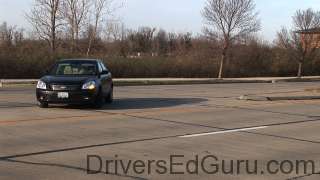Stage 3: Two-point, Three-point, and U-Turns – Part 1
Location: City and residential streets
Length of Lesson: 35-45 minutes
I don’t want to get off on a rant here, but I find it so frustrating that our driver licensing system puts a huge emphasis on parallel parking, but ignores so many other important skills. Now, I understand the reasons (although it doesn’t excuse the system’s ineptitude) why the behind-the-wheel test doesn’t include highway driving. It has to do with safety and funding. However, I find it inexcusable that the behind-the-wheel test doesn’t cover two-point, three-point, and u-turns. These maneuvers are tricky, yet they are a necessity for every driver. Parallel parking, on the other hand, while important, isn’t a skill that every single driver uses. There are many drivers who will go years without needing to parallel park.
I apologize for going off on a tangent there. The point is that being able to reverse your driving direction is darned important. There are 3 ways to do this: two-point, three-point, and u-turns.
Let’s start with U-Turns

When practicing u-turns with your teen, the most important task is to determine whether or not it’s legal to make the turn. Your job is to show your teen where to look for the no u-turn sign. As long as there isn’t a sign, you can safely assume that performing a u-turn is an acceptable action…sort of.
Just because there’s isn’t a “No U-Turn Sign”, it doesn’t mean it’s safe
We’ve all witnessed the driver who attempts to make a u-turn and half-way through the turn realizes that they’re not going to make it. If they continued forward, they’d end up hitting the curb of the new road. So, what do they do? They reverse in the middle of traffic which is essentially performing a 3-point turn.
It’s difficult for most cars to perform a u-turn unless they’re turning into a road with two lanes. Performing a 180-degree turn within the width of one lane is impossible…unless you’re driving a bicycle.
To avoid this type of disaster and successfully complete a U-Turn, follow these steps:
- Make sure that approaching vehicles are more than 200 feet away.
- Activate your left turn signal and begin braking.
- Check your rearview mirror to make sure that no one is tailgating you. Tapping your brakes will indicate to other drivers that you’re going to slow down. Your turn signal should also make this clear. However, since the driver behind you doesn’t know you’re making a u-turn (which requires a slower approach than a left turn), they may follow too closely. That’s why it’s important to slow down early.
- Position your car in the right side of your lane (be careful not to drift into the lane next to you).
- It can be tempting to swing wildly out to the right before making your u-turn. Don’t do this. You’re not driving a truck. If the turn is so tight that this is required, you shouldn’t be attempting a u-turn.
- Turn your wheel to the left as far as it will go. Brake through the beginning of the turn. As you start to exit the turn, lightly accelerate.
- If your turn signal doesn’t turn off automatically (which would be extremely odd in the case of a u-turn), turn it off.
What exactly is a “point”?
I get this question fairly often. A “point”, in the context of two-point and three-point turns, is defined as a spot where your vehicle stops and subsequently initiates a turn.
So, during a two-point turn, your vehicle will come to rest twice before the turn is completed. In a three-point turn, it will stop a total of three times before you finish the turn. Therefore, a u-turn would be defined as a zero-point turn.
Practice Tips
- Be a second set of eyes: When practicing two-point and three-point turns with your new driver, you should be checking their mirrors religiously. These turns are tricky and nerve-wracking for new drivers. Whenever you’re changing directions or driving across lanes of traffic, you must be diligent in checking traffic in all directions.
- Help them judge closing distances: New drivers don’t yet have a great feel for the closure rates of oncoming cars. They also don’t have a good feel for how long it’s going to take them to complete a maneuver such as reversing into a driveway or completing a three-point turn. For instance, help them determine when it’s safe to initiate a three-point turn. You don’t want them to block traffic or cause a dangerous situation.
Two-point Turns
Two-point turns are a safer way to change direction than a three-point turn. Whenever possible, perform a two-point turn as opposed to a three-point. You can perform two-point turns on the left or right side of the street.
In Stage 2, you practiced <changing directions by reversing on a street>. This included two variations of two-point turns. So, your teen should have some experience with this maneuver.
Learn more about two-point turns in part 2.

